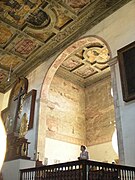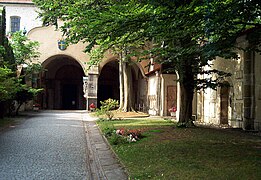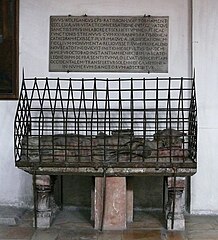St. Emmeram (Regensburg)
St. Emmeram is a church building in Regensburg that was started around 780 . The church was the main church of the Sankt Emmeram monastery , which was elevated to a prince abbey in 1731 . After the secularization , the abbey church became the parish church of the city of Regensburg and Pope Paul VI. on March 5, 1964 with the Apostolic Letter Terra sacra raised to the minor basilica .
Buildings and history
According to credible tradition, Saint Emmeram was buried around 690 in a St. George's church in place of the later monastery church. His first grave was in front of the southern apse of today's church. The exact location and shape of this Georgskirche is not known.
The core of today's building was built around 780 under Abbot Bishop Sintpert (768–791). It was a flat-roofed church with at least one apse in the east, which was surrounded by an external, vaulted and still preserved ring crypt . A denomination allowed a view from the ring crypt of the newly created grave of Emmeram under the main altar. Wall paintings from the time it was built have been preserved in the crypt. It is not clear whether this Carolingian church already had three aisles like today and how far it reached to the west. Extensive excavations in the interior of the church are missing.
The extension of another rectangular outer crypt in the east under Abbot Ramwold around 980 is secured. It was vaulted over two pillars, but was rebuilt in the Baroque period. The abbot was buried there in the year 1000/1001 in an extension on the south side. There are indications that it was only then that the church was converted into a three-aisled basilica , of which parts of the central nave piers and the upper aisle wall in the east are still preserved.
Around 1050 a spacious west transept with a hall crypt was built to accommodate the remains of Saints Dionysius and Wolfgang von Regensburg . The three medieval stone reliefs on the north portal, the earliest of their kind in Germany (around 1052), depict Jesus Christ , St. Emmeram of Regensburg and St. Dionysius .
Various fires required renovations, one of which, after a fire in 1166, profoundly changed the nave. The result was a flat-roofed basilica with richly structured central nave walls.
From 1731 to 1733 the redesign was carried out by the brothers Cosmas Damian and Egid Quirin Asam in the Baroque style , whereby the spatial conditions of the 12th century were largely retained.
St. Emmeram as the final resting place
In the church of St. Emmeran and in the front garden to the north, which also belongs to the directly adjacent parish church of St. Rupert , there are 83 grave monuments; there are also 14 grave monuments in the parish church. 35 of the 83 are now in the front garden, but come from former graves in the Ruperti cemetery, which was abandoned after 1806, to the east. They mostly belong to people from the environment of the court of the Princes of Thurn and Taxis. The remaining 48 of the 83 grave monuments are located in the Church of St. Emmeran, some with the associated grave sites. Of these grave monuments, some are particularly worth mentioning, which are named below in a non-systematic order:
Under the Dionysius Choir in the West, is Wolfgang's - crypt , the final resting place Bishop Wolfgang. The Wolfgang shrine itself is in an illuminated niche under the altar. In addition to the Dionysius altar in the north aisle, the tomb of the blessed Queen Hemma († 876), wife of Louis the German , is inserted into the wall.
Queen Hemma
The following were also buried in Sankt Emmeram: St. Emmeram , the Blessed Abbot Ramwold , St. Klausnerin Aurelia , the Blessed Bishops Wolflek, Gaubald and Tuto , the East Franconian King and Roman Emperor Arnulf of Carinthia and his son King Ludwig the Child , the Bavarian Duke Arnulf the Evil and the Bavarian historian Johannes Aventinus . There are also the remains of the catacomb saints St. Maximianus and St. Calcidonius in glass shrines .
The most impressive and largest grave monument of St. Emmeran is in the western transept at the south exit of the Wolfgang crypt. The 5 m high epitaph was built in 1777 for Alexander Ferdinand von Thurn und Taxis , principal commissioner at the Perpetual Reichstag in Regensburg, who died in 1773 and was buried in the Wolfgang crypt . The black marble inscription is flanked by symbolic female figures of justice and prudence; above under a canopy stands the female figure of the church with a cross, chalice and host.
Next to the large Thurn Taxis epitaph is the grave monument of the Prussian ambassador to the perpetual Reichstag, Ernst Reichsgraf von Metternich , on the south wall . The Calvinist envoy had become Catholic the day before his death (December 27, 1727). His body was laid out in St. Emmeran and then buried with pomp and three days of bells ringing. The ambassador's conversion caused a sensation beyond the city of Regensburg, and the epitaph and the inscription provoked the Protestant ambassadors at the Reichstag and the population. The female figure on top of the epitaph symbolizes the holy Catholic Church to which Count Metternich, finally reappearing from the floods of his Calvinist religion, had returned. In the inscription, all visitors are urged to emulate him and convert too.
Behind the ambassador's conversion, however, there are secular motives and a dramatic family history, because the conversion took place behind the back of the wife and with the help of the daughter. After the epitaph had been erected for her husband in St. Emmeran, the strictly Protestant wife, who was seriously disappointed by her husband, had an epitaph for her son Ernst Eberhard von Metternich , who died young ten years earlier, at her own expense in the envoys cemetery at the Dreieinigkeitskirche .
Furnishing
Interior
The west transept has a painted wooden ceiling showing Benedict of Nursia . The baroque high altar dates from 1669.
Organs
Main organ

St. Emmeram has a long organ tradition with representative and large instruments: there was an organ in the Romanesque church as early as 1166. Abbot Johann II Tergernbeck had an "artful organ" set up in 1474. The installation of a baroque gallery in the rear third divided the huge originally Carolingian church building. In 1669 , Christoph Egedacher installed an organ on this gallery , the case of which has been preserved. The disposition and number of registers of the organs mentioned so far have not been handed down. In 1731 Johann Konrad Brandenstein rebuilt the plant. The disposition then read:
|
|
|
||||||||||||||||||||||||||||||||||||||||||||||||||||||||||||||||||||||||||||||||||
This work was rebuilt in 1846 by Johann Heinssen from Regensburg and its sound changed; later repaired by Anton Breil in 1880 . In 1900, Binder & Siemann built a movement with a cone chest and pneumatic action in the existing case as its Opus 90 . The organ had two manuals and 30 stops. At that time the instrument was already one of the largest in the Regensburg area.
In 1959, Eduard Hirnschrodt again set up a new work: the organ, with 68 sounding stops on four manuals and pedal with cone door and electro-pneumatic action, was the largest instrument in the Diocese of Regensburg before the Waldsassen organ system was implemented. After the rebuilding of the organ in the cathedral in 2009, it is currently the second largest organ in the city of Regensburg. Eduard Hirnschrodt reused many pipes from the previous organ. Due to the division into the main organ and west organ (in the westwork of the church), the church interior can be optimally sounded. The organ also has a one-manual pneumatic emergency play table , made by the binder workshop of unknown origin. With the bellows from 1900, which has since been removed , the second manual of the organ could previously be used as a makeshift in cooperation with a calculator .
The disposition, created by Heinrich Wismeyer, is:
|
|
|
|
|
|||||||||||||||||||||||||||||||||||||||||||||||||||||||||||||||||||||||||||||||||||||||||||||||||||||||||||||||||||||||||||||||||||||||||||||||||||||||||||||||||||||||||
(o) = swell for upper voices
- Pair : II / I, III / I III / II, IV / I, I / P, II / P, III / P, IV / P
- Playing aids : 3 free combinations , crescendo roller , 2 swell kicks for upper and lower voices, crescendo down, general reeds down, mixtures down, 2 free piano pedal combinations and single reed holders, western organ on.
Chest positive
A chest organ with four registers from Sandtner has been available since 1997 for mobile use and for thorough bass purposes.
Bells
The mighty, free-standing bell tower is considered the most important building of the Renaissance in Regensburg. It was built from 1575 to 1579, replaced an older, ailing tower and is described in the Sankt Emmeram monastery . The tower houses six bells in the striking notes b 0 , c 1 , des 1 , f 1 , as 1 and b 1 . Five minutes before the Sunday office (9:55 a.m.), all bells except the largest one ring; it is only used on high festivals . Bell 4 (f 1 ) serves as "Angelus bell", the smallest bell rings as "poor soul bell" following the evening Angelus . The clock strikes via the bells of 1 (quarter hours) and c 1 (full hours).
literature
- Peter Morsbach: St. Emmeram zu Regensburg, former Benedictine abbey church. (= Great Art Guide 187). Schnell & Steiner, Munich / Regensburg 1993.
- Jochen Zink: On the early construction history of the former Benedictine abbey church St. Emmeram in Regensburg up to the turn of the millennium. In: Karl Möseneder , Gosbert Schüssler (ed.): “Meaning in the pictures”. Festschrift for Jörg Traeger on his 60th birthday. Schnell & Steiner, Regensburg 2002, pp. 501-541.
- St. Emmeram in Regensburg. History, art, preservation of monuments. Contributions to the Regensburg Autumn Symposium from November 15–24, 1991 (= Thurn-und-Taxis-Studien, 18). Kallmünz 1991.
- Gabriele Peschel: The medieval building history of the former Benedictine monastery church St. Emmeram in Regensburg according to the current state of research. In: 1250 years of art and culture in the diocese of Regensburg. Reports and Research. Munich / Zurich 1989, pp. 47–78.
- Jochen Zink: On the early construction history of the former Benedictine monastery church St. Emmeram in Regensburg. In: 1250 years of art and culture in the diocese of Regensburg. Reports and Research. Munich / Zurich 1989, pp. 79–194.
- Günter Lorenz: The double niche portal of St. Emmeram in Regensburg. Studies on the beginnings of the church portal in the 8th to 11th centuries (= European university publications - XXVIII series). Frankfurt am Main 1984.
- Eberhard Kraus : Historic organs in the Upper Palatinate. Schnell & Steiner 1990, ISBN 3-7954-0387-1 , pp. 268 and 352 f.
Web links
- St. Emmeram Basilica . In: Regensburg-Bayern.de
- Website of the parish of St. Emmeram
Individual evidence
- ↑ Paul VI .: Litt. Apost. Terra sacra. In: AAS , 56 (1964), No. 15, pp. 915f.
- ↑ Peschel 1989.
- ↑ Herbert Kößler, Hans Schlemmer: Monuments in St. Emmeran. A Latin-German tour. 2nd edition, Herbert Kößler, Regensburg 2008, ISBN 978-3-00-018979-1 .
- ↑ Herbert Kößler, Hans Schlemmer: Monuments in St. Emmeran. A Latin-German tour. 2nd edition, Herbert Kößler, Regensburg 2008, ISBN 978-3-00-018979-1 , p. 97.
- ↑ Klaus-Peter Ruess: Burials and grave monuments on the "Kirch-Hoff zur Heyligen Dreyfaltigkeit" at the Dreieinigkeitskirche. Regensburg State Library 2015, p. XXXIf.
- ^ Albrecht Klose, Klaus-Peter Rueß: The grave inscriptions on the ambassador's cemetery in Regensburg. ( Regensburg Studies, Vol. 22.) Regensburg City Archives 2015, ISBN 978-3-943222-13-5 , pp. 65–67.
- ^ Organ database Bavaria Version 5 (2009), ed. by Michael Bernhard
Coordinates: 49 ° 0 '55.4 " N , 12 ° 5' 33.7" E
















